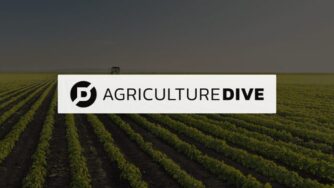CIBO was featured in an article by AgTechNavigator by Oliver Morrison which explored how the AgTech sector is reducing farmers’ risk of adopting regenerative farming practices. CIBO Technologies is used as an example of a company that uses software to simplify sourcing and accessing public and private incentives and partnerships with grower-focused organizations to help farmers participate in conservation programs. CIBO CEO Dan Ryan is quoted several times within the article, highlighting the challenges farmers face in knowing what opportunities are available, the difficulty in program enrollment, data collection for applications, and limited estimates of return before entering the application process.
Article Summary
Farmers don’t need to be told about the risks of climate change or learn more about how regenerative practices can create more ecologically and economically robust agricultural systems. It simply remains a risk for them to adopt new practices. Thankfully there’s an agtech sector working to reduce it. There appears to be a significant gap in the climate-smart and regenerative agriculture market. These practices are crucial, it’s believed, to decarbonize agriculture systems, to make farming more resilient to climate change, and to reverse and restore biodiversity and soil fertility.
The problem, according to McKinsey, is a need for more operational and financial support. In other words, the risk is just too high. Despite acknowledging the long-term benefits of sustainable practices, for example, many farmers still anticipate that the cost of sustainability will remain 1 to 3% higher even after five years. McKinsey also notes that government programs have substantially higher participation among farmers than industry programs. Some 57% of farmers surveyed have joined a government program versus just 4% for industry-sponsored.
According to McKinsey, this could indicate that government programs are driving adoption and that continued programmatic support from governments and industry players may encourage more farmers to transition to sustainable farming practices. There are, however, moves in the industry aimed at combining public and private resources to drive a more rapid adoption of conservation agriculture.
CIBO Technologies, for example, uses data, analytics, and software to simplify program enrollment and help farmers more easily discover what incentives are available and what they are eligible for. CIBO partners with grower-focused organizations such as co-ops, agronomists, and retailers to help their farmer customers access USDA conservation programs and ‘stack’ public and private incentives for adopting sustainable practices. Thus, the company believes it can help farmers maximize the potential returns on conservation practices available to them.
How to make regenerative agriculture a profitable reality for farmers
“Up to now there’s not been an easy way of farmers knowing what’s available to them,” CIBO CEO Dan Ryan told AgTechNavigator at the World Agri-Tech Innovation Summit. The public and private sector initiatives on offer for farmers include NRCS programs and new tax credits like the Clean Fuel Production Credit (45Z), as well as Scope 3 reduction and carbon credit programs. These programs are also “super complicated for farmers to enroll in,” Ryan told us. “Farms are asked to provide reams of data, and it takes months of time to do this work before they even know if they are eligible. So we’ve tried to eliminate that whole problem.”
The idea is that growers enter their field boundaries onto a CIBO platform and immediately see the programs they might be eligible for. “We also try to estimate right up from what the return will be,” Ryan said. “It breaks done one adoption barrier – namely the time and hassle of working out what your eligible for.”
Meanwhile, while there are various programs on offer to farmers, “none on their own is really sufficient to cover the cost of the transition and also the risk that farmers receive during the transition. So the idea is how can we simplify and bring incentives to farmers more effectively and hopefully combine the incentives.”
Given there remains a lack of advance financing available to farmers, the ROI is key he said. “The idea is how can we get the most dollars to farmers.” By stacking a USDA grant on top of a corporate carbon removal program, “instead of getting 20-30 dollars an acre, you’re getting 60-90, which could really help accelerate this transition.”
Climate change is, quite simply, an existential threat to the company, Jess Newman, McCain’s senior director of agriculture and sustainability told a panel discussion at the World Agri-Tech Innovation Summit. “It’s about security supply. I can point to my bottom line and say exactly what it costs us. Our why for sustainability is supply security and making sure the children of the growers actually want to grow potatoes someday. It’s a pretty existential threat to our business if they don’t want to.”
“The whole supply chain needs to work together from an incentive structure,” said McCain’s Jess Newman. “We’re going to be seeing a piloting of cost sharing at a level that we’ve probably never seen before. I think in the next five years there’s going to be a really exciting flow of the agronomic and economic data set around some practices so no one’s just relying on the government to cost share.”



